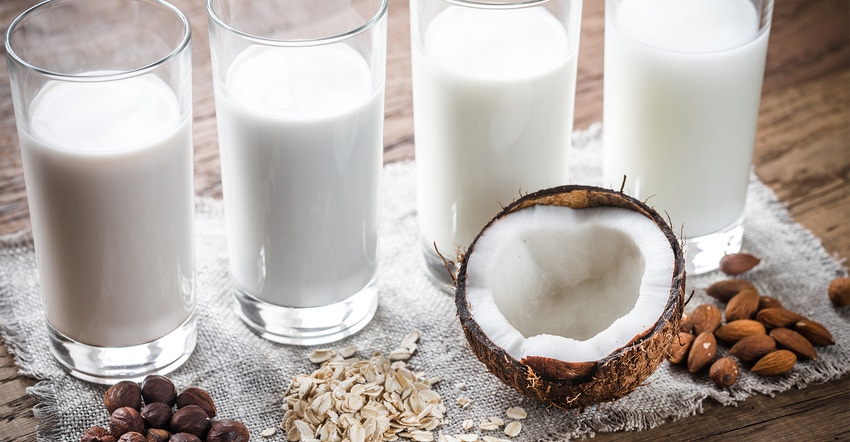The shift in preference toward animal milk substitutes is part of a bigger picture, where consumers are opting for minimally processed natural food and drinks.

Animal milk has been a dietary staple around the world, obtained from livestock such as cows, buffalos, goats, sheep and camels. Cow’s milk contains oleic acid, conjugated linoleic acid (CLA), omega-3 fatty acids, short- and medium chain fatty acids, vitamins, minerals and bioactive compounds may, which research shows may promote positive health effects.1 Milk is usually consumed as a standalone drink or used to mix cereals for breakfast. Milk products such as cheese, butter and yogurt have also have versatility and are frequently incorporated in modern day cuisine. However, modern studies are increasingly stating that animal milk might not be as good as previously thought.2
Animal milk
Some, such as nutrition researcher Kris Gunnars, argue it’s against the rule of nature to consume milk produced by other mammals. Livestock’s naturally produce milk to feed their offspring, like a human mother lactates to feed her newborn baby. Although animal milk contains a multitude of nutrients and vitamins that benefit humans, it’s possible to consume them from other sources. More importantly, these animals receive hormones to ensure continuous lactation. Such an act is not only unnatural but also borderlines animal abuse.
Due to this fact, several humans develop an intolerance towards lactose, an important component found in animal milk. Moreover, the antibiotics that are pumped into livestock have resulted in the surge of antibiotic-resistant bacteria, which might infect humans through the consumption of their milk, according to USDA. Recent studies have also shown that the consumption of cow milk and milk products is linked to a higher risk of bone fracture,3 and ovarian4 and prostate cancer. Animal milk purchased in supermarkets and convenience stores is pasteurized and homogenized and contains preservatives that extend their shelf life.
Substitutes for animal milk
Milk obtained from free-range livestock not subjected to copious amounts of hormones and antibiotics is significantly more natural than most store-bought milk. However, the availability of such milk is limited. Nonetheless, the prevalence of milk substitutes derived from plants is gaining considerable momentum. The most common of them are almond, soy and coconut milk. Although such plant-based milk contains lower amounts of nutrients as compared to that of livestock, they virtually have no side effects on humans who are not allergic. Additionally, they can be used to produce cheese and butter. In fact, the dairy alternative market is expected to grow at a substantial rate soon, driven by an increase in awareness towards the negative effects and artificiality of consuming animal-based milk and milk products, according to Allied Market Research.
The rise in demand for natural food and drinks
The surge in demand for animal milk substitutes is part of a bigger global picture, a shift toward consuming healthy and fresh food. The demand for organic and non-GMO foods has increased worldwide. Consumers are increasingly opting for natural foods and drinks that don’t contain any artificial sweeteners, colors, flavors and additives like hydrogenated oils, stabilizers, and emulsifiers. The global natural food and drinks market is poised to reach US$192 billion by 2023, growing at a rate of 13.7 percent from 2017, according to Allied Market Research.
Even France, a country known for their rich and sumptuous cuisine, is in the middle of modifying its national nutrition guidelines. The new guidelines encourage higher consumption of fresh produce, whole grains, plant-based proteins, and good unsaturated fats such as walnuts and olive oils. The current guideline, which was published in 2011, recommended intake of meat, dairy, refined grains and sugary beverages. The shift of consumer awareness towards natural food and drinks is also being increasingly backed by government regulations, and the trend is only becoming more widespread with time.
Rajarshi Mukherjee is a content writer at Allied Analytics LLP (alliedanalytics.com). Holding a master of science in hydrology and water resources, he one day wishes to educate the public regarding the dangers of anthropogenic global warming. For now, he finds solace in writing about breakthroughs in science and technology. He also possesses an avid interest in world politics and football.
References
Haug A, Høstmark A, Harstad O. “Bovine milk in human nutrition—a review.” Lipids Health Dis. 2007; 6: 25. DOI: 10.1186/1476-511X-6-25
Abid Z, Cross A, Sinha R. “Meat, dairy, and cancer.” Am J Clin Nutr. 2014 Jul; 100(1): 386S–393S. DOI: 10.3945/ajcn.113.071597
Feskanich D et al. “Milk, dietary calcium, and bone fractures in women: a 12-year prospective study.” Am J Public Health. 1997 Jun;87(6):992-7.
Larsson S, Bergkvist L, Wolk A. “Milk and lactose intakes and ovarian cancer risk in the Swedish Mammography Cohort.” Am J Clin Nutr. 2004 Nov;80(5):1353-7.
Ornish D et al. “Dietary trial in prostate cancer: Early experience and implications for clinical trial design.” Urology. 2001 Apr;57(4 Suppl 1):200-1.
About the Author(s)
You May Also Like




.png?width=800&auto=webp&quality=80&disable=upscale)